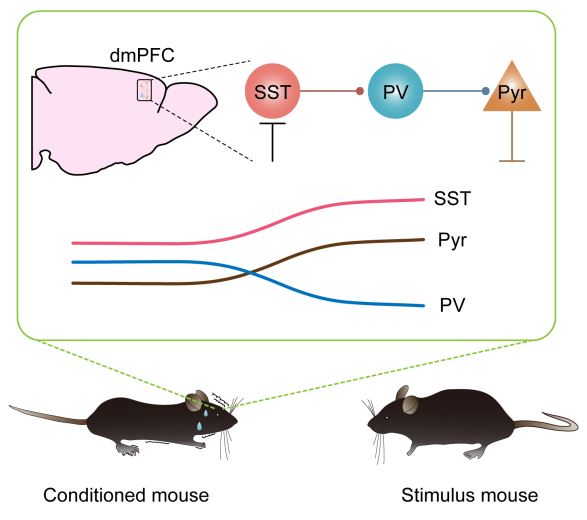Dysfunction of “traffic light” for microcircuits contributes to SAD
This video clip is shot in Prof. XU Han’s laboratory at the School of Medicine. Compared to the mouse on the left, the one on the right shows a clear escape and avoidance behavior, a typical symptom of social fear. This is a novel mouse model designed by XU’s group to understand the pathological mechanism of social phobia. Using this model and a series of elegant experiments, an important dysfunction in the microcircuits is found to contribute to social anxiety disorder (SAD).This work is published in Neuron.
Social anxiety disorder is featured by excessive blushing, excess sweating, trembling, palpitations, and nausea. Sufferers try every means to avoid social situations. Therefore, social avoidance and social phobia are two most typical behaviors. To shed light on the neural mechanism underlying psychiatric diseases, a proper animal model is important.
Based on classical conditioning theory of the famous Russian physiologist Ivan Pavlov, XU et al. developed a social fear conditioning (SFC) paradigm to induce social fear in mice. In contrast with conventional social fear paradigms, this conditioned mouse didn’t develop any generalized anxiety and depression behavior. It was therefore an appropriate animal model for precise research into the neural mechanism behind SAD.
XU et al. found that when the experimental mouse experienced social anxiety, a considerable body of neurons in the prefrontal cortex was activated and that its social anxiety was enormously diminished by the inactivation of the dorsal medial prefrontal cortex (dmPFC) through a pharmacological approach, suggesting that the dmPFC mediated social fear expression directly.
With a combination of in vivo electrophysiological recordings and fiber photometry together with cell-type-specific pharmacogenetics, XU et al. further demonstrated that somatostatin (SST) interneurons (INs) suppressed parvalbumin (PV) INs, which is the green light of traffic control. When this light functions improperly, the pyramidal cells are disinhibited, which enhances the dmPFC ouput to mediate social fear responses.

These findings revealed a previously unknown disinhibitory microcircuit in the prefrontal cortex through interactions between IN subtypes and suggested that SST INs-mediated disinhibition represents an important circuit mechanism in gating social fear behavior.

Reviewers of the journal of Neuron made remarkably complimentary remarks about this research. Comments include: “This is a very intriguing and important research” and “A very fascinating job and a thrilling new discovery.”“We will delve deeper into this field and strive to uncover mechanistic details of this disease, thus supporting the development of a more accurate and effective cure for SAD,” XU Han said in an interview.